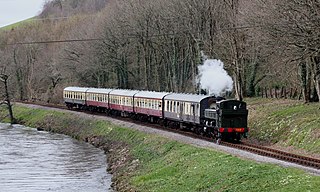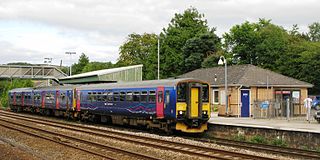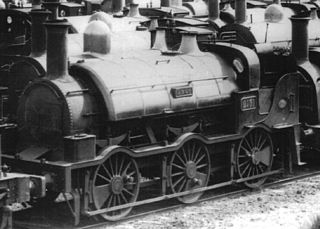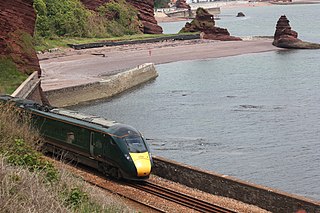
The Great Western Railway (GWR) was a British railway company that linked London with the southwest, west and West Midlands of England and most of Wales. It was founded in 1833, received its enabling Act of Parliament on 31 August 1835 and ran its first trains in 1838 with the initial route completed between London and Bristol in 1841. It was engineered by Isambard Kingdom Brunel, who chose a broad gauge of 7 ft —later slightly widened to 7 ft 1⁄4 in —but, from 1854, a series of amalgamations saw it also operate 4 ft 8+1⁄2 in standard-gauge trains; the last broad-gauge services were operated in 1892.

The South Devon Railway (SDR) is a 6.64-mile (10.69 km) heritage railway from Totnes to Buckfastleigh in Devon. Mostly running alongside the River Dart, it was initially known as the Dart Valley Railway. The railway is now operated by the South Devon Railway Trust, a registered charity.

Newton Abbot railway station serves the town of Newton Abbot in Devon, England. It is 214 miles 5 chains (345 km) from London Paddington. The station today is managed by Great Western Railway, who provide train services along with CrossCountry.

Totnes railway station serves the towns of Totnes and Dartington in Devon, England. It was opened by the South Devon Railway Company in 1847. Situated on the Exeter to Plymouth Line, it is 222 miles 66 chains measured from the zero point at London Paddington via Box.

The Cornwall Railway was a 7 ft 1⁄4 in broad gauge railway from Plymouth in Devon to Falmouth in Cornwall, England, built in the second half of the nineteenth century. It was constantly beset with shortage of capital for the construction, and was eventually forced to sell its line to the dominant Great Western Railway.

Plymouth Millbay railway station was the original railway terminus in Plymouth, Devon, England. It was used for passenger trains from 1849 to 1941. It was rebuilt in 1903.

The Bristol and Exeter Railway (B&ER) was an English railway company formed to connect Bristol and Exeter. It was built on the broad gauge and its engineer was Isambard Kingdom Brunel. It opened in stages between 1841 and 1844. It was allied with the Great Western Railway (GWR), which built its main line between London and Bristol, and in time formed part of a through route between London and Cornwall.

Laira Traction and Rolling Stock Maintenance Depot is a railway traction maintenance depot situated in Plymouth, Devon, England. The depot is operated by Great Western Railway (GWR) and is where their fleet of High Speed Trains are overhauled along with those belonging to CrossCountry. These will be withdrawn in 2023 but it will then become the principal depot for GWR's Class 802 InterCity Express Trains. Other trains visit for daily servicing.
The Buckfastleigh, Totnes and South Devon Railway built the broad gauge railway line from Totnes to Buckfastleigh and Ashburton in Devon, England.
The Comet class were 12 4-4-0ST broad gauge locomotives operated on the South Devon Railway and associated railways. They were designed for passenger trains on this steep and sharply curved line but were also used on goods trains when required.
The four Tornado class locomotives were 0-6-0ST broad gauge locomotives operated on the South Devon Railway and associated railways. They were designed for goods trains but were also used on passenger trains when required.

The eight Dido class locomotives were 0-6-0ST broad gauge locomotives operated on the South Devon Railway and Cornwall Railway and associated other adjacent railways. They were designed for goods trains but were also used on passenger trains when required.

The South Devon and Tavistock Railway linked Plymouth with Tavistock in Devon; it opened in 1859. It was extended by the Launceston and South Devon Railway to Launceston, in Cornwall in 1865. It was a broad gauge line but from 1876 also carried the standard gauge trains of the London and South Western Railway between Lydford and Plymouth: a third rail was provided, making a mixed gauge. In 1892 the whole line was converted to standard gauge only.
The South Devon Railway Company built and operated the railway from Exeter to Plymouth and Torquay in Devon, England. It was a 7 ft 1⁄4 in broad gauge railway built by Isambard Kingdom Brunel.

The North Devon Railway was a railway company which operated a line from Cowley Bridge Junction, near Exeter, to Bideford in Devon, England, later becoming part of the London and South Western Railway's system. Originally planned as a broad gauge feeder to the Bristol & Exeter Railway, it became part of a battle between the broad gauge group and the standard gauge railway interests. In this context, standard gauge lines were often described as narrow gauge.

There are eleven disused railway stations on the Exeter to Plymouth line between Exeter St Davids and Plymouth Millbay in Devon, England. At eight of these there are visible remains.
The South Devon Banks are a series of steep inclines on the ex-GWR railway line linking Exeter and Plymouth in Devon, England. These two cities are separated by the rocky uplands of Dartmoor forcing the early railway surveyors to propose that the line skirt the difficult terrain of the comparatively sparsely populated moorland. Isambard Kingdom Brunel, in surveying the South Devon Railway, opted to push a line along a coastal strip between the Exe and Teign valleys, and then to climb the southern outliers of Dartmoor making for the head of the Plym estuary. From Newton Abbot, the line climbs Dainton Bank, and from Totnes it climbs Rattery Bank, reaches a peak at Wrangaton summit, and then descends Hemerdon Bank to reach Plymouth. These three are collectively known as the South Devon Banks.

The network of railways in Plymouth, Devon, England, was developed by companies affiliated to two competing railways, the Great Western Railway and the London and South Western Railway. At their height two main lines and three branch lines served 28 stations in the Plymouth area, but today just six stations remain in use.

The Plymouth to Yealmpton Branch was a Great Western Railway single track branch railway line in Devon, England, that ran from Plymstock to Yealmpton. The line was planned as part of a route to Modbury, but the scheme was cut back to Yealmpton; it opened in 1898, and the passenger train service ran from Plymouth Millbay, but road competition led to declining usage and the passenger service was withdrawn in 1930.

The Exeter–Plymouth line, also called the South Devon Main Line, is a central part of the trunk railway line between London Paddington and Penzance in the southern United Kingdom. It is a major branch of the Great Western Main Line and runs from Exeter St Davids to Plymouth, from where it continues as the Cornish Main Line. It was one of the principal routes of the Great Western Railway which in 1948 became part of the Western Region of British Railways and are now part of the Network Rail system.















